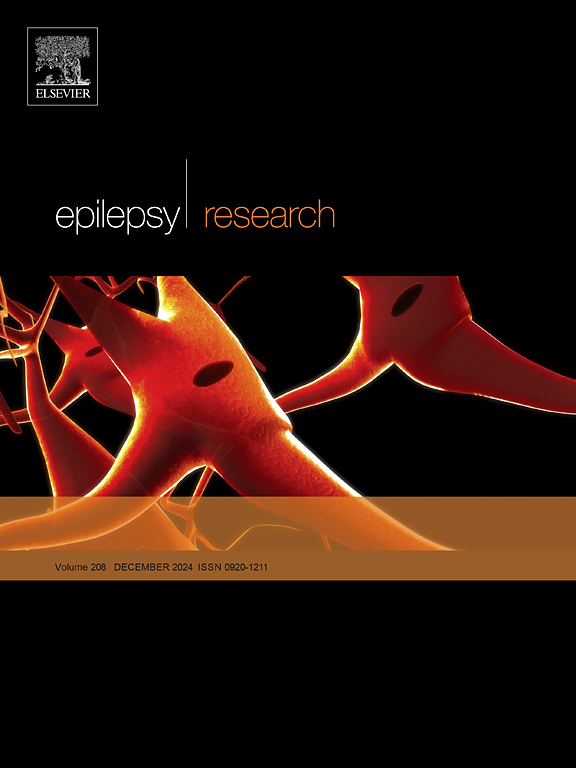Natural history of epilepsy in FOXG1 Syndrome
IF 2
4区 医学
Q3 CLINICAL NEUROLOGY
引用次数: 0
Abstract
Background
FOXG1 syndrome is rare neurodevelopmental disorder with microcephaly, brain malformations, epilepsy, and cognitive and motor disabilities as major features. Knowledge of the clinical features is primarily from case series and a foundation sponsored registry. We expand insight into epilepsy in FOXG1 syndrome by examining longitudinal data from 94 individuals from a multi-site natural history study and local cohorts.
Methods
Clinical information on severity, seizure type, and seizure features was collected from 68 individuals enrolled in the Rett Syndrome and Related Disorders Natural History Study and extracted via retrospective chart review from 15 individuals seen at the Children’s Hospital of Philadelphia Rett Syndrome Center of Excellence and 11 individuals from Children’s Hospital of Colorado. Genotype-phenotype and other correlations were assessed using non- and semi-parametric analyses.
Results
78.7 % of participants had seizures, beginning at a median age of 1.0 years. Individuals were followed for a median of 4.9 years after first seizure onset. Taken independently, over 70 % of seizures were partial or tonic-clonic, occurred less than weekly, and lasted less than 5 min. 1/3 of seizures resolved in a median time and age of 1.1 and 3.3 years. Age had a weak non-linear association with average seizure frequency, and, for those with seizures, smaller head circumference correlated with increased disease severity.
Conclusions
We further characterize disease severity and epilepsy in FOXG1 syndrome and demonstrate that smaller head circumferences are associated with more severe disease and age is weakly non-linearly correlated with average seizure frequency. This information will improve clinical care and aid therapeutic development.
FOXG1综合征患者癫痫的自然病史
foxg1综合征是一种罕见的神经发育障碍,以小头畸形、脑畸形、癫痫、认知和运动障碍为主要特征。临床特征的知识主要来自病例系列和基金会赞助的注册。我们通过检查来自多地点自然历史研究和当地队列的94个个体的纵向数据,扩大了对FOXG1综合征癫痫的了解。方法收集参加Rett综合征及相关疾病自然史研究的68例患者的严重程度、癫痫发作类型和癫痫发作特征的临床信息,并通过回顾性图表分析从费城儿童医院Rett综合征卓越中心的15例患者和科罗拉多州儿童医院的11例患者中提取。使用非参数和半参数分析评估基因型-表型和其他相关性。结果78.7% %的参与者癫痫发作,中位年龄为1.0岁。这些个体在首次癫痫发作后的平均随访时间为4.9年。单独观察,70%以上 %的癫痫发作为部分性或强直阵挛性发作,发生时间少于一周,持续时间少于5 分钟。1/3的癫痫发作在中位时间和年龄分别为1.1岁和3.3岁时消退。年龄与平均癫痫发作频率呈弱非线性关联,对于癫痫发作的患者,较小的头围与疾病严重程度增加相关。结论我们进一步表征了FOXG1综合征的疾病严重程度和癫痫,并证明较小的头围与更严重的疾病相关,年龄与平均癫痫发作频率呈弱非线性相关。这些信息将改善临床护理和帮助治疗发展。
本文章由计算机程序翻译,如有差异,请以英文原文为准。
求助全文
约1分钟内获得全文
求助全文
来源期刊

Epilepsy Research
医学-临床神经学
CiteScore
0.10
自引率
4.50%
发文量
143
审稿时长
62 days
期刊介绍:
Epilepsy Research provides for publication of high quality articles in both basic and clinical epilepsy research, with a special emphasis on translational research that ultimately relates to epilepsy as a human condition. The journal is intended to provide a forum for reporting the best and most rigorous epilepsy research from all disciplines ranging from biophysics and molecular biology to epidemiological and psychosocial research. As such the journal will publish original papers relevant to epilepsy from any scientific discipline and also studies of a multidisciplinary nature. Clinical and experimental research papers adopting fresh conceptual approaches to the study of epilepsy and its treatment are encouraged. The overriding criteria for publication are novelty, significant clinical or experimental relevance, and interest to a multidisciplinary audience in the broad arena of epilepsy. Review articles focused on any topic of epilepsy research will also be considered, but only if they present an exceptionally clear synthesis of current knowledge and future directions of a research area, based on a critical assessment of the available data or on hypotheses that are likely to stimulate more critical thinking and further advances in an area of epilepsy research.
 求助内容:
求助内容: 应助结果提醒方式:
应助结果提醒方式:


